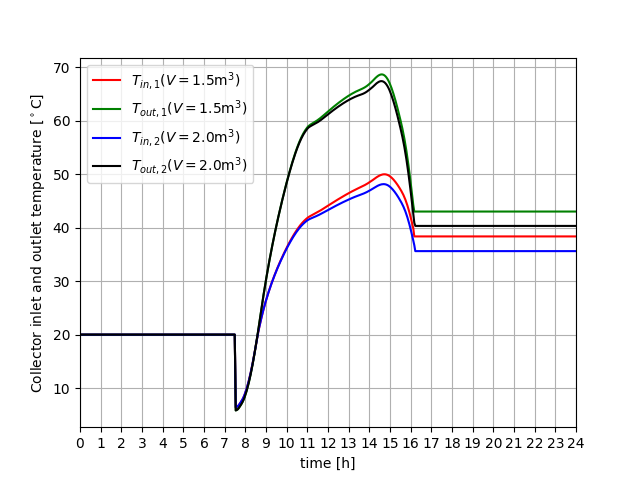Examples¶
Simulating a model with two different parameter values¶
This module provides an example that illustrates the use of the python to run a Modelica simulation.
The module
buildingspy.simulate that can be used to automate running simulations.
For example, to translate and simulate the model
Buildings.Fluid.SolarCollectors.Examples.FlatPlateWithTank
from the Modelica Buildings Library, release 11.0.0,
with different sizes for the water tank, use
the following commands:
#!/usr/bin/env python
# -*- coding: utf-8 -*-
#
from multiprocessing import Pool
from buildingspy.simulate.Dymola import Simulator
# Function to set common parameters and to run the simulation
def simulateCase(s):
""" Set common parameters and run a simulation.
:param s: A simulator object.
"""
s.setStopTime(24 * 3600)
# Kill the process if it does not finish in 1 minute
s.setTimeOut(60)
s.printModelAndTime()
s.simulate()
def main():
""" Main method that configures and runs all simulations
"""
import shutil
# Build list of cases to run
li = []
# First model, from Modelica Buildings Library, v11.0.0
model = 'Buildings.Fluid.SolarCollectors.Examples.FlatPlateWithTank'
s = Simulator(model, outputDirectory='case1')
s.addParameters({'tan.VTan': 1.5})
li.append(s)
# second model
s = Simulator(model, outputDirectory='case2')
s.addParameters({'tan.VTan': 2})
li.append(s)
# Run all cases in parallel
po = Pool()
po.map(simulateCase, li)
po.close()
po.join()
# Clean up
shutil.rmtree('case1')
shutil.rmtree('case2')
# Main function
if __name__ == '__main__':
main()
This will run the two test cases and store the results in the directories
case1 and case2. To use Optimica instead of Dymola, replace in the
above script Dymola with Optimica.
Plotting of Time Series¶
This module provides an example that illustrates the
use of the python to plot results from a Dymola simulation.
See also the class buildingspy.io.postprocess.Plotter
for more advanced plotting.
The file plotResult.py illustrates how to plot results from a
Dymola output file. To run the example, proceed as follows:
Open a terminal or dos-shell.
Set the PYTHONPATH environment variables to the directory that contains
`buildingspy`as a subdirectory, such ascd buildingspy/examples/dymola export PYTHONPATH=${PYTHONPATH}:../../..Type
python plotResult.py
This will execute the script plotResult.py, which contains
the following instructions:
#!/usr/bin/env python
# -*- coding: utf-8 -*-
#
def main():
""" Main method that plots the results
"""
import os
import matplotlib
matplotlib.use('Agg')
import matplotlib.pyplot as plt
from buildingspy.io.outputfile import Reader
# Optionally, change fonts to use LaTeX fonts
# from matplotlib import rc
# rc('text', usetex=True)
# rc('font', family='serif')
# Read results
ofr1 = Reader(os.path.join("buildingspy", "examples", "dymola",
"case1", "FlatPlateWithTank.mat"), "dymola")
ofr2 = Reader(os.path.join("buildingspy", "examples", "dymola",
"case2", "FlatPlateWithTank.mat"), "dymola")
(time1, TIn1) = ofr1.values("TIn.T")
(time1, TOut1) = ofr1.values("TOut.T")
(time2, TIn2) = ofr2.values("TIn.T")
(time2, TOut2) = ofr2.values("TOut.T")
# Plot figure
fig = plt.figure()
ax = fig.add_subplot(111)
ax.plot(time1 / 3600, TIn1 - 273.15, 'r', label='$T_{in,1}(V=1.5 \\mathrm{m^3})$')
ax.plot(time1 / 3600, TOut1 - 273.15, 'g', label='$T_{out,1}(V=1.5 \\mathrm{m^3})$')
ax.plot(time2 / 3600, TIn2 - 273.15, 'b', label='$T_{in,2}(V=2.0 \\mathrm{m^3})$')
ax.plot(time2 / 3600, TOut2 - 273.15, 'k', label='$T_{out,2}(V=2.0 \\mathrm{m^3})$')
ax.set_xlabel('time [h]')
ax.set_ylabel(r'Collector inlet and outlet temperature [$^\circ$C]')
ax.set_xticks(list(range(25)))
ax.set_xlim([0, 24])
ax.legend()
ax.grid(True)
# Save figure to file
plt.savefig('plot.pdf')
plt.savefig('plot.png')
# To show the plot on the screen, uncomment the line below
# plt.show()
# Main function
if __name__ == '__main__':
main()
The script generates the following plot:

